| Notes: Liverpool Central station’s low level platforms were the eastern terminus of the underground Mersey Railway that linked Birkenhead to Liverpool via a tunnel under the River Mersey. The Mersey Railway was authorised in 1871 but work did not start until the end of 1879 when shafts were sunk at Liverpool and Birkenhead. Tunnelling began in 1881 from both sides. |
 |
The tunnels met beneath the middle of the river in 1884, only one inch out of perfect alignment. The tunnel was the first in the world to be built under a tidal estuary. The line, which initially ran from James Street in Liverpool to Green Lane in Birkenhead, was opened by the Prince of Wales on 20th January 1886. At the time of opening it carried 20,000 people on weekdays. In 1888 the line was extended to Birkenhead Park where it made a connection with the Wirral Railway, and in 1891 to Rock Ferry where it connected with the Great Western Railway/London North Western Railway.
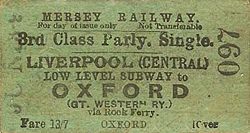 |
The James Street terminus was not adjacent to any of Liverpool’s main line railway termini. To address this the Mersey Railway built an extension from James Street to the Cheshire Lines Committee (CLC) Liverpool Central Station. The extension was in a tunnel underneath Lord Street and Church Street which finished beneath platforms 1 and 2 of the CLC |
station; it opened on 11th January 1892.
The Mersey Railway station at Liverpool Central had a main entrance on Ranelagh Street, west of the main line station. Steps led down to a passageway that connected to an island platform which was quite narrow for the levels of traffic that it handled. A short section of tunnel continued southwards underneath the main line tracks of the CLC; this was used to allow the Mersey Railway Trains to run round.
To facilitate easier interchange access was also provided directly into the main line station. A passageway led to steps that came out at the northern end of the main line station’s platform 4.
| At the time of opening regular trains ran from the Mersey Railway’s Liverpool Central station to Birkenhead Park and to Rock Ferry. They were steam-hauled by specially built locomotives, designed to create less smoke. Nevertheless the tunnels did fill with smoke and the environment of Low Level station soon became unpleasant. At the time of opening it had |
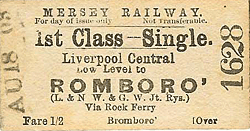 |
been hoped that main line services would operate from the low level platforms to destinations beyond the Mersey Railway network. In the latter half of the 1890s through coaches ran from Liverpool Central Low Level to Corwen, Folkestone and London Paddington. A few specials also ran into the station from the Wrexham area. The Folkestone coaches provided through connections to Paris Gare du Nord. Departure from Liverpool Central Low Level was at 8.00am with arrival at Paris Gare du Nord at 10.50pm on the same day. The return working left Paris at 3.45pm and arrival at Liverpool Central was at 6.29am the next morning. The coaches were provided by the GWR which worked trains to and from Rock Ferry, where the Mersey Railway took over.
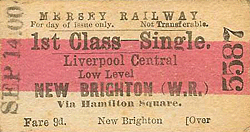 |
The operating costs for the Mersey Railway were very high due to the ventilation systems required to remove the smoke from the engines. They considered electrification which had been adopted by both the City & South London Railway and, closer to home, by the Liverpool Overhead Railway. The company however could not raise the finance. In 1899 George |
Westinghouse visited Great Britain with a view to expanding his business. He saw the Mersey Railway and considered that it would be an excellent test bed for his company’s products. Over the next few years his company built a substation at Birkenhead, cleaned out thousands of tons of soot, and installed third and fourth live rails. The system was energised at 650dc, and electric trains began to run on 3 May 1903.
The introduction of electric trains was an immediate success: passenger numbers soared. An intensive train service was introduced, and Liverpool Central Low Level had departures every few minutes running alternately to Rock Ferry and to Birkenhead Park. The line became a typical ‘metro’ railway that had much in common with the London Underground network which was developing at that time.
| In 1923 the grouping of most of the railway companies of Great Britain into four large regional organisations (LMS, LNER, GWR, SR) took place. However the Mersey Railway remained independent, as did the CLC, although it was two-thirds owned by the LNER and one-third LMS). The platform at Liverpool Central was widened during the 1920s. |
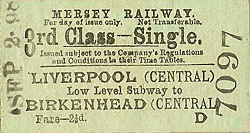 |
From 14 March 1938 trains from Liverpool Central Low Level served West Kirby and New Brighton as the LMS had electrified these lines to allow through running. The extended services proved popular, resulting in thousands more passengers using the cramped facilities.
On 1st January 1948 Liverpool Central low and high level stations became part of the British Railways (London Midland Region).
 |
The British Railways timetable for September 1956 showed 260 departures from Liverpool Central LL on weekdays, with trains every few minutes from 6.00 am until 11.33 pm. The Low Level platforms were fitted with LMR totem signs which were unusual in being 4ft in length, 3ft being the standard size. The main line platforms did not receive totems. |
For many decades linkage of the separate railways in Liverpool city centre had been under consideration. There had long been a desire to create a through route from Liverpool Central to Liverpool Exchange, the terminus of the Lancashire and Yorkshire Railway on the northern side of the city centre, and to link the Mersey Railway with the other terminus stations. Nothing had come of the plans until 1966 when MALTS (Merseyside Area Land Use Transportation Study) was carried out by the local authorities. It recommended the creation of a loop railway from James Street linking the major lines, and a link railway from Liverpool Central Low Level to Liverpool Exchange. The deep level loop was proposed to pass through Liverpool Central and would have its own platform.
| The Reshaping of British Railways (Beeching) report of 1963 had recommended the closure of Liverpool Central High Level by diverting all services into Lime Street via the Allerton Curve. In September 1966 all services, except those to Gateacre, were diverted to Liverpool Lime Street. British Railways intended to withdraw the Gateacre service but local pressure kept |
 |
it in operation. The main line part of the station remained busy only because Low Level passengers used the concourse.
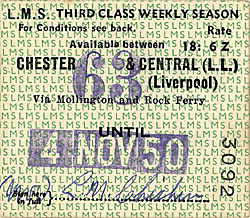 |
In 1969 the Merseyside Passenger Transport Authority (MPTE) was formed. It took the MALTS study forward and it provided financial assistance for rail services within its area which it branded Merseyrail. The services from Low Level station became Merseyrail Wirral Line services. In 1971 the MPTE obtained an Act to build new underground lines in the city centre and electrify existing routes. The new lines followed the principles laid down in MALTS. Liverpool Central Low Level would become part of the link line between Central and Exchange - the latter would close and be replaced with a new underground |
station at Moorfields). The link would be part of the Merseyrail Northern Line.
In 1971 work began, and the access to the main line station from the Low Level station was closed leaving only the Renalagh Street entrance. On 15 April 1972 the last Gateacre trains ran, and High Level station officially closed on 17April. Demolition had already begun.
Liverpool Central Low Level lingered on for a few more years, but eventually it was required for the building works. It closed on 28th July 1975, and all trains on the Wirral Line terminated at James Street. A Rail-link bus service was introduced between Liverpool Central and James Street.
| After closure the tunnel was opened out, the station’s platform seeing daylight for perhaps the first time ever. The tunnel to the south of Low Level was extended so that it came out into the former approach tunnels of the CLC line. A section of the original Mersey Railway tunnel between Central and James Street was used as part of the link line. Under Paradise Street a junction |
 |
was created with two single-bore tunnels to carry the link through to the former L&YR lines. The site of the Low Level station was used for the Northern Line platforms of a new Merseyrail Liverpool Central station. Deep beneath it a new platform was created on the loop line.
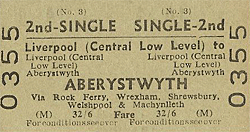 |
The new station on the site of Liverpool Central Low Level opened to traffic on 2 May 1977, initially as a terminus for trains from Southport, Ormskirk and Kirkby. A week later,on 9th May, the deep Level platform opened serving Wirral line trains. From 3 January 1978 the former Low Level station saw through-running when the line to Garston reopened. |
By 2011 the Merseyrail station at Liverpool Central had become the busiest on the network and one of the busiest stations outside of London.
Tickets from Michael Stewart. Click here for more tickets from Liverpool Central Low Level
Sources:
See Also
Liverpool Central High Level & Liverpool Central Merseyrail
|

central_ll_old2.jpg)
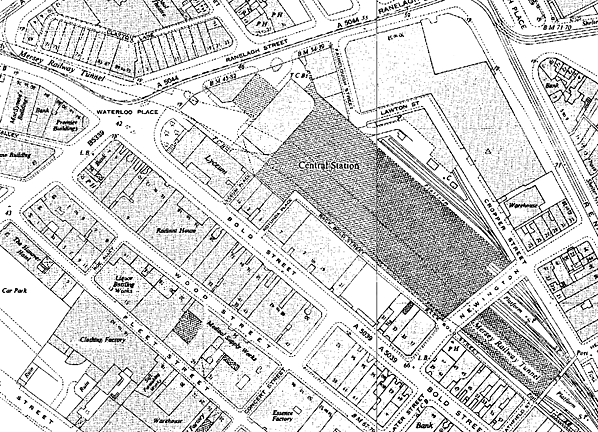 1955 1:2,500 OS map showing shows the course of the Mersey Railway tunnel running below the High Level station.
1955 1:2,500 OS map showing shows the course of the Mersey Railway tunnel running below the High Level station.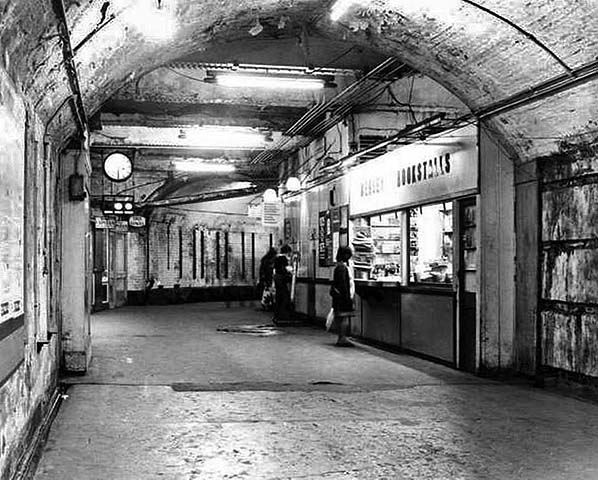
central_ll_old5.jpg)
central_ll_old4.jpg)
central1.jpg)
central_ll_old1.jpg)






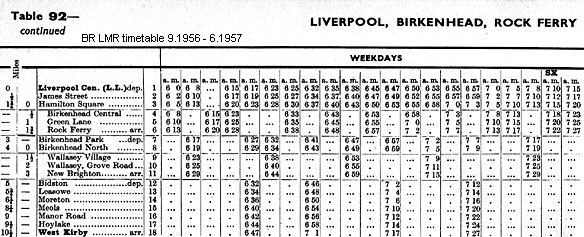








 Home Page
Home Page